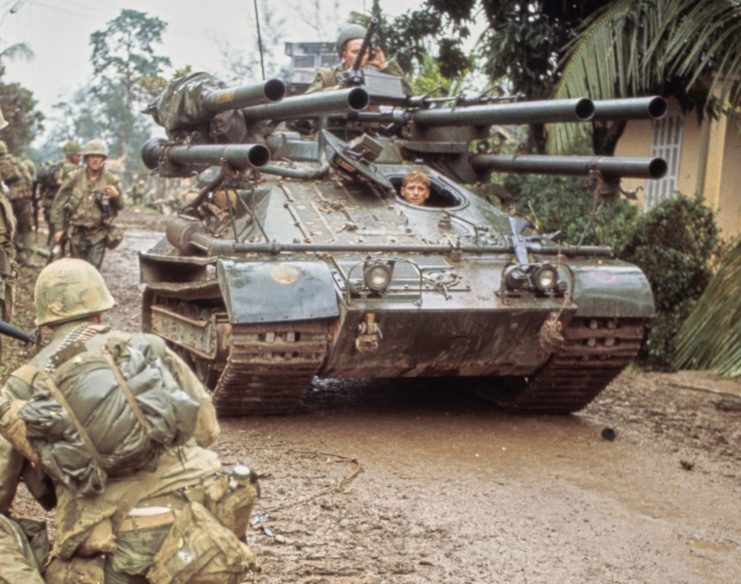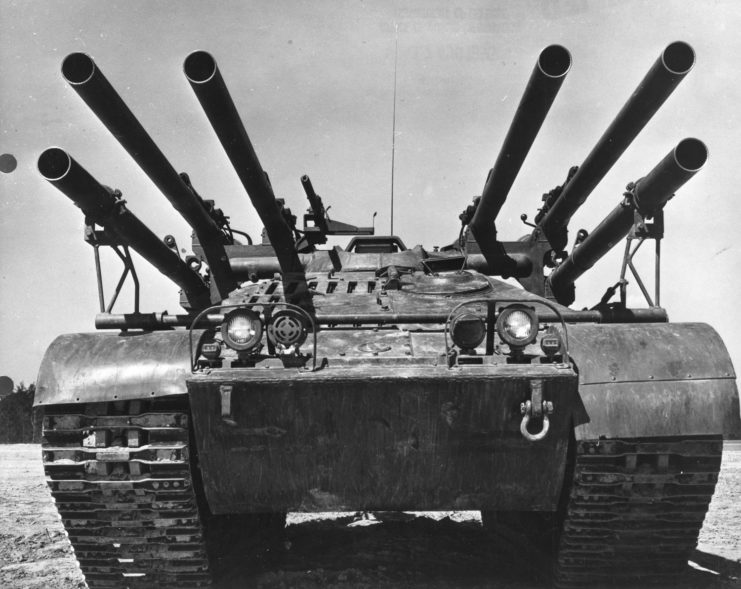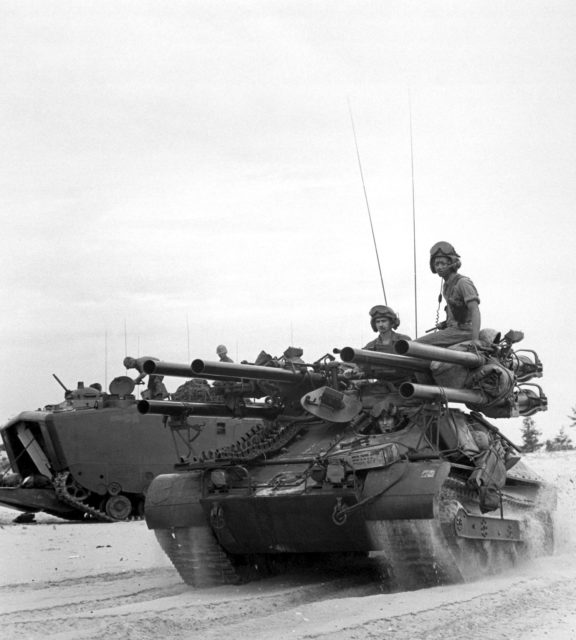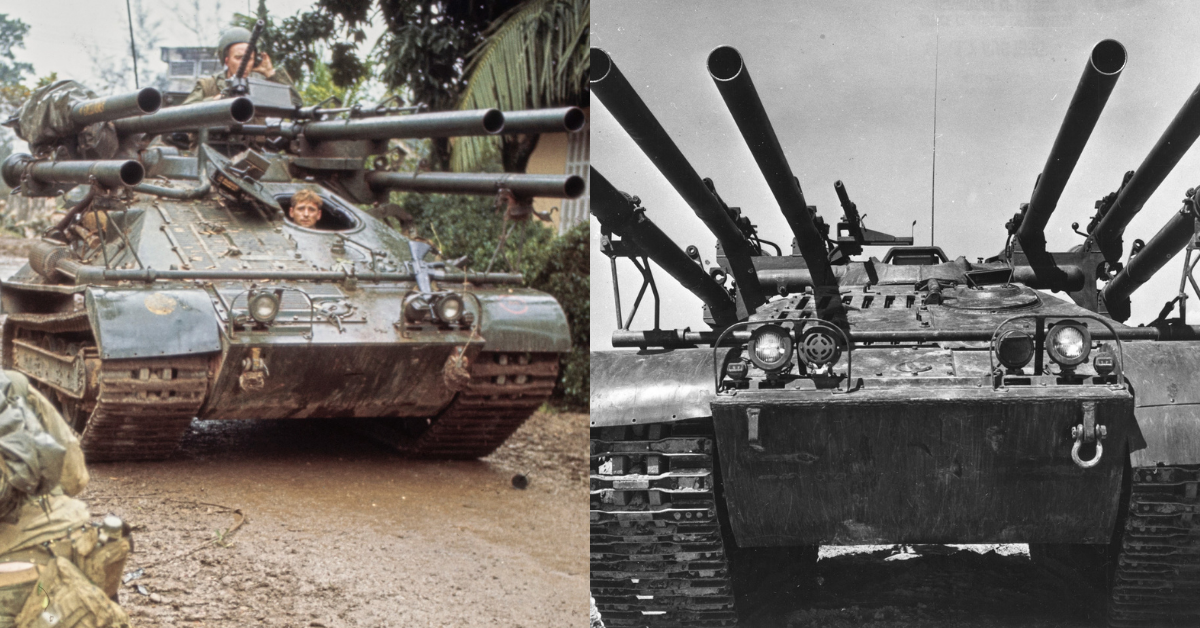In the early 1950s, the US was on the hunt for a lightweight air-transportable tank destroyer. Similar attempts were made during WWII, but limitations in cargo aircraft carrying capacity limited the vehicles’ armor and firepower so much that they were effectively useless against enemy tanks. The M50 Ontos would be the result of a joint US Army and Marines project to produce a lightweight tank destroyer, but in the end, only the Marines would end up actually using this odd little vehicle.
Ontos is Greek for “thing”, which perfectly encapsulates the strange design of the M50.
A small, compact yet powerful vehicle that could be air-dropped into battle was a design with plenty of potential and flexibility, but building such a vehicle would come with some challenges. Engineers had calculated that the proposed tank destroyer would have to weigh between 10-20 tons to be air-transportable while still offering effective capabilities.
The M50 Ontos

The M50 would use a small, low-profile fully-tracked hull and an enclosed compartment for the crew. As it needed to be moved by air, thin armor protection was one of the simplest ways to keep the weight low. Subsequently, the M50 only had 13 mm on the hull (about the same as a WWI Mark 1 tank) and just 6.5 mm on the underside.
But the M50’s showstopper was its main armament of six 106 mm recoilless rifles. Well, actually, they were 105 mm recoilless rifles but were named 106 mm to avoid confusion with the previous M27 recoilless rifle.
The vehicle was so small and light that a conventional anti-tank weapon would recoil too violently, so a recoilless rifle was used instead. Recoilless rifles use a clever technique to balance out most of the recoil forces generated when firing by venting some of the propellant gasses out the rear of the weapon to counteract the recoil. This allows the rifle to fire a much larger caliber round than conventional weapons of a similar size and weight.
Each could be fired individually, or in one single shot. While undergoing trials at the Aberdeen Proving Ground, an M50 fired all six rifles at once, blowing the bricks out of a nearby building while also shattering glass on nearby parked cars.
The guns were mounted to a small semi-traversable turret that could rotate up to 40 degrees on each side. It could elevate the guns up 20 degrees, and depress them 10 degrees. It lacked a complex targeting system, so the M50 used .50 caliber ranging guns on the rifles that had similar ballistic performance to the main armament. The gunner would fire a ranging round, which glowed brightly on its way to the target, emitting a puff of white smoke when it arrived. This would then be used as an aiming reference.
It was powered by a 5 liter inline 6 GMC engine that provided the vehicle with 145 hp. Despite its low power, the M50 was highly mobile and had a top speed of 30 mph, as it weighed just 8,600 kgs.
Tested, then rejected
When the M50 Ontos completed testing in 1955, the US Army rejected it. They considered the vehicle as too lightly armored (only capable of stopping .50 caliber rounds at most), too small, which made it cramped for the crew, and it didn’t carry enough ammunition. But the Army’s main issue with the vehicle was reloading the rifles. To reload, a crew member had to exit the vehicle, exposing themselves to enemy fire. The Army deemed this unacceptable. The US Marines were impressed though and ordered nearly 300.
Impressive service

Although the Army rejected the M50, it actually served with great success for the Marines. The Vietnam War was where it really shined.
It was designed as a tank destroyer, but the Marines used it as a highly mobile fire support platform that could relocate around the battlefield quickly and providing devastating fire with its six recoilless rifles.
Its portability meant it could be taken almost anywhere and move through the jungle much easier than other heavier vehicles. During Vietnam, the CH-53 Sea Stallion helicopter arrived in service with the US and was able to carry the M50 underneath.
Against fortifications or buildings, the M50 could fire High Explosive Squash Head (HESH) rounds, which were also useful for creating new entrances in walls in urban warfare. It was particularly deadly against mass-formations of soldiers, where it would fire “beehive” anti-personnel rounds, which are essentially super-sized shotgun rounds.
The US’ enemies in Vietnam quickly learned to fear the M50, and would often retreat at the sight of one.
Although it was extremely useful, the M50 Ontos would be removed from service in 1969.
End of the road for the “Thing”

The drawbacks deemed acceptable by the Marines would eventually prove too much to bear.
The large back-blast created by the recoilless rifles was dangerous to nearby troops, and the exposed reload process put the loader at risk. On top of this, the vehicle’s low ammunition storage made it unpractical in drawn-out engagements.
However, the biggest problem was its survivability. The M50’s thin armor was simply useless against larger caliber weapons and even large fragments of shrapnel. Anti-tank mines were especially lethal, due to the thin belly armor on the M50. And when the vehicle was damaged, its ammunition was prone to explode.
Regardless, the Ontos had served much better than many predicted, and terrified the enemy in the process.
Col. Stanley S. Hughes, the commander of the 1st Marines at Hue said “If any single supporting arm is to be considered more effective than all others, it must be the 106 mm recoilless rifle, especially the M50 Ontos.”
